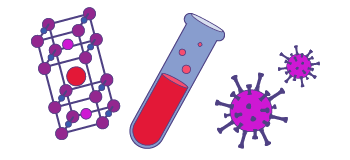Electrospray ionization (ESI) is a popular technique in mass spectroscopy for ionizing samples before they are measured. ESI works well with heavier compounds and is therefore often used in proteomics (analysis of proteins) and petroleomics (analysis of petroleum).

The sample is mixed with a solvent and introduced into a vessel, called a capillary, that ends in a very fine tip. A very high voltage is applied to this tip, which charges the molecules in the solvent. Because they are highly charged with the same charge, these molecules, once they are pushed through the nozzle into the Evaporation Chamber, repel one another almost violently. When the charged liquid first exits the tip, it briefly forms a cone shape (known as a Taylor cone) before the droplets burst away from each other into a fine spray.
Released from the nozzle, the droplets in the spray go through a series of divisions. This occurs because the solvent within these droplets gradually evaporates (with the assistance of nitrogen gas pumped into the chamber), forcing the charges in the molecules within these droplets (which, again, are identical) closer together. When these ions are pushed close enough together, they will repel each other (this behavior is known as the Coloumb force), causing the droplets to divide into two smaller droplets. This process repeats itself until the solvent is completely evaporated and the droplets have split up to the point that each is a single, charged molecule. One of the advantages of this ionization method is that the molecules remain intact and will not be broken apart; this is what is meant when this type of ionization is called soft.

Explore our magnet schedule to see what exciting research is happening on our stellar fleet of instruments right now.
Last modified on 08 August 2023